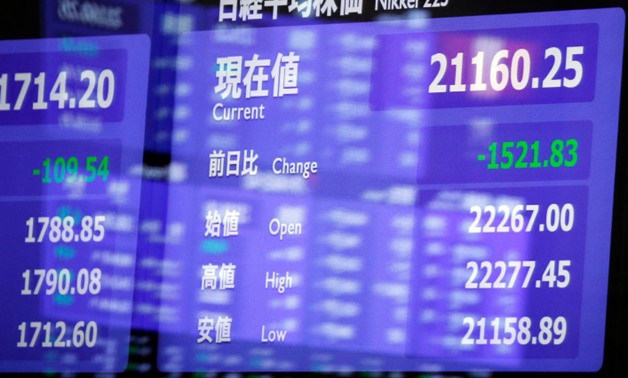
An electronic board showing the Nikkei share average is seen as market prices are reflected in a glass window at the Tokyo Stock Exchange (TSE) in Tokyo, Japan, February 6, 2018. REUTERS/Toru Hanai
SYDNEY - 7 February 2018: Asian share markets took back some of their earlier gains on Wednesday as investors were unnerved by a drop in U.S. stock futures, underscoring lingering anxiety following steep losses in global equities over the past few days.
While most analysts believed distressed selling looked to have run its course for the moment, allowing volatility to abate a little, the prospect of monetary tightening across the globe remained a challenge for the long term.
“If we look at some of the drivers of the recent volatility – the natural correction and the bond sell-off – we don’t foresee any of these factors contributing to a lengthy period of extreme volatility,” said Tom Kenny, senior economist at ANZ.
“The correction is probably a healthy development and is not reflective of a souring of the macroeconomic outlook.”
Investors took their cue from a late rebound on Wall Street, though many had an anxious eye on E-Mini futures for the S&P 500 which were off 0.3 percent in Asian trading.
MSCI’s broadest index of Asia-Pacific shares outside Japan was last up 0.8 percent after rising as much as 2 percent in early trades.
Japan’s Nikkei eased too but was still up 1.6 percent. Chinese blue chips fell more than 1 percent while South Korea’s KOSPI index was also in the red.
“The only surprise about the current volatility is that it hasn’t happened sooner. Normally, even in a bull market, investors should expect a sell-off of 10-percent-plus at some point,” said Richard Titherington, chief investment officer of EM Asia Pacific Equities at J.P. Morgan Asset Management.
“While a major market downturn is possible, it is not our current expectation. The underlying backdrop of an improving global economy, a weakening US dollar and a pickup in global earnings all remain supportive factors.”
The Dow had ended Tuesday up 2.33 percent, while the S&P 500 added 1.74 percent and the Nasdaq 2.13 percent. The Dow carved out a 1,100-point trading range in all, a painful return of volatility to a market that until recently was marked by an absence of major shifts.
It was also a wild ride for Treasuries overnight, with U.S. 10-year yields diving as deep as 2.65 percent before a fresh sell-off dragged them back up to 2.80 percent - the sort of range seen very rarely.
Bonds had started to see some buying again, a hint that risk appetite might be returning with the potential to trigger another spasm of selling in stocks.
BLAME THE ALGOS
It was a steep spike in yields last Friday that sparked the initial rout on Wall Street, forcing sales by a host of highly leveraged funds which ramped up volatility and drove yet more selling.
Many of these were algorithmic funds crowded into similar trades - long stocks and short volatility. The selling then cascaded through their computer systems in a way almost beyond human intervention.
The pivotal gauge of S&P 500 volatility, the VIX, did come off almost 20 points overnight but was still relatively elevated at 29.98 percent.
“Short volatility funds were caught by the spike in the VIX and had to cover,” said Greg McKenna, chief market strategist at CFD and FX provider AxiTrader.
“You’re a genius until you’re not and when it takes just a day or two to unwind your whole strategy then you were never a genius,” he added. “But volatility does cluster, so there is no guarantee that markets are out of the woods yet.”
In currencies, investors found safe harbor in the Japanese yen while riskier plays such as the Australian and New Zealand dollars declined.
The U.S. dollar fell 0.3 percent to 109.29 yen, still above Tuesday’s trough of 108.43.
The euro was a touch firmer at $1.2390, while the dollar was a touch softer against a basket of currencies to 89.647.
Gold, another supposed safe harbor, advanced 0.3 percent to $1,328.90 an ounce after touching a three-week low at $1,319.96.
Oil prices were strong too, with U.S. crude for April adding 56 cents to $63.96. Brent crude futures gained 52 cents to $67.38 a barrel.


Comments
Leave a Comment